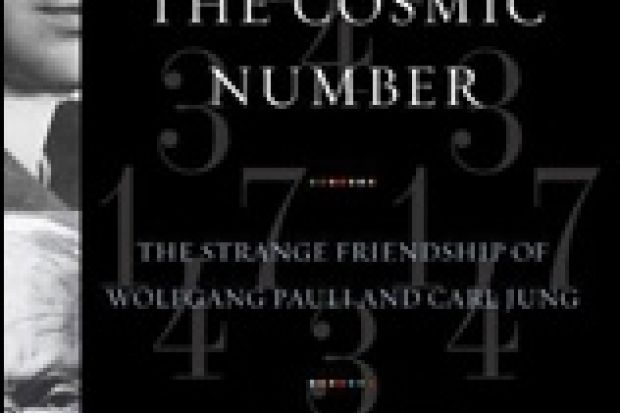Wolfgang Pauli was admired as a blazingly confident theoretical physicist but also feared as a pitiless critic of every woolly or illogical idea. In 1932, when he was at his peak, few of his colleagues would have guessed that this prince of intellectual rigour was seeking psychiatric help on the couch of Carl Jung.
The two became close, but it appears that none of Pauli's physicist friends knew about the relationship; most of them were dead when it became widely known in 1984. Eight years later, their correspondence was edited by Charles Meier, Jung's colleague in Zurich. His little-read collection Atom and Archetype: The Pauli/Jung Letters 1932-1958 is a rich source of insights into the mind of each of the men and the differences between their approaches to each other's professional interests.
Arthur I. Miller, the distinguished historian of physics, has cleverly hit on the idea of using the relationship between the two men to give an interdisciplinary perspective on Pauli's life. The book serves as the first popular biography of this outstanding scientist and is long overdue.
One of the virtues of Miller's account is the accessibility of its science. He highlights Pauli's most important contributions to physics, including his successful prediction of the neutrino (an elusive fundamental particle) and his discovery of the exclusion principle, essential to the modern understanding of atoms and stars. Pauli was also an influential critic of ideas hatched by others, notably his friend Werner Heisenberg, discoverer of quantum mechanics. The problem was that Pauli's aggressive criticism often went well beyond the usual macho joshing and became destructive. Pauli's competitor Paul Dirac resented this and, in later life, would point out that Pauli's achievements should be weighed against his energetic attempts to crush at birth several concepts that turned out to be correct, notably the concept of electron spin.
For me, Miller overstates Pauli's importance as an original thinker. As Pauli himself admitted near the end of his life, he came to appreciate that he "was but a classicist and no revolutionary". Others knew this long before: in 1933, the Nobel Committee noted correctly that "Pauli's receptivity exceeds his originality" and it would be 12 more years before Pauli won the Nobel Prize for Physics. In all probability, he would have had it much earlier if he had not been repeatedly so rude to the committee.
Although he was extremely successful in his work, the early 1930s were not a happy time for Pauli. Still grieving the recent suicide of his mother, he had married in 1929 but the union ended less than a year later, when his wife left him - to his chagrin - not for a high achiever but merely for "a mediocre chemist" (by the name of Goldfinger).
It was apparently Pauli's inability to find a mate that led him to seek Jung's help. By 1938 he had mellowed, a change that may have been due in part to the success of Jung's treatment, Miller suggests. Possibly. What is certain is that Jung had widened Pauli's horizons, introducing him to psychological ideas that, in my view, were so vague (and impossible to falsify) that Pauli would have savaged them if he had heard them in a seminar room.
Yet it is undeniably fascinating to read Pauli's recollected dreams and Jung's attempts to understand them. These sections, the highlight of the book, give valuable insights into a great scientist addressing his own personality in ways that transcend his own expertise. But the two men often debated science, with Pauli continually having to strain to keep Jung on the right track and away from a tendency to become entangled in piffle.
One of the questions they explore is why the prime number 137 repeatedly crops up in quantum physics, in connection with the strength of the electromagnetic force (the number emerges in a combination of the speed of light, the charge of the electron and Planck's constant). Many physicists, including Pauli, strove to explain this number, and it is no surprise that Jung - always drawn to mysticism - became intrigued by the problem. In the context of the entire book, this is a minor theme so it is a little surprising that it gives the book its title.
Pauli's second wife did her best to prevent the publication of his correspondence with Jung, fearful that they would damage her husband's scientific reputation. After reading Miller's rewarding book, one can only be relieved that her wish was denied. For one thing, the letters demonstrate how seriously Pauli took questions on which his own expertise had little purchase, as well as his affection for Jung. It is no surprise to learn that, when Pauli was dying in a Zurich hospital, Jung was the last person he asked to see. One can only wonder what Jung thought when he heard the number of Pauli's room: 137.
Deciphering the Cosmic Number: The Strange Friendship of Wolfgang Pauli and Carl Jung
By Arthur I. Miller. W.W. Norton & Co, 384pp, £18.99. ISBN 9780393065329. Published 29 May 2009.
Register to continue
Why register?
- Registration is free and only takes a moment
- Once registered, you can read 3 articles a month
- Sign up for our newsletter
Subscribe
Or subscribe for unlimited access to:
- Unlimited access to news, views, insights & reviews
- Digital editions
- Digital access to THE’s university and college rankings analysis
Already registered or a current subscriber? Login
